Learning Hub | Search Engine Optimization (SEO)
How do I Pick the Right SEO Keywords?
August 12, 2016 | Jon Teodoro

The process of choosing the right SEO keywords can be viewed as a puzzle or matching game more so than a thing of art. Sure, truly successful keywords – those ones that camouflage naturally into the surrounding text to everyone but Google – need some creativity peppered in there.
But, just because you are a good writer does not mean that you have a jumpstart to understanding SEO. This is because SEO has little to do with the actual art of writing and more to do with spotting trends and making logical conclusions based on your knowledge of your target audience’s psychology. (If you’d like to learn more about the basics, check out our blog about what SEO is and how you can improve it.)
Now, you might not have gone into reading this blog thinking that we would mention the P word. But, marketers that don’t realize that every single step of inbound marketing in some way deals with customers’ psychology is dropping the ball.
Merriam-Webster defines psychology as “the science or study of the mind and behavior” and “the way a person or group thinks.”
Voilá! If you can successfully put yourself into the brain of your target audience members and figure out what they are likely to be searching for, then you can successfully choose keywords that will match and resonate with search engines like Google.
The more your keywords match what your audience is typing, the more likely it is for Google to recognize your site as a high search result, drawing traffic to your business.
But don’t worry, you don’t just have to guess at all of this and wait around for a few months to see if your site moves up on the SERPs (search engine results page). In fact, there really should be no guessing at all except for in the very first stages of keyword brainstorming. Most of your decisions should be based on logical, data-backed evidence.
So, how do you get that? Read on, my good friends!
A Step-by-step Process of Picking the Right SEO Keywords
I want to share with you the process that we go through here at Verde. I’m sure all marketers have a slightly different way or order of doing things. But no matter our differences, you can be sure that the software I mention below is bookmarked on most of our computers.
You can think of the SEO process as a big funnel. At the top are all of the keyword options that you could think of that might reflect your audience members’ needs. Each step down the funnel will narrow your options until, finally, you reach the optimal keyword phrase.
So, what’s the optimal phrase? It is one that flows seamlessly throughout your page content and also matches what your potential customers are searching so well that search engines will pick up on it.
Think of it as a marriage between audience and content, and search engines like Google are the officiant. Ready to recite those vows?
This process is not hard. You just have to know where to begin and have a clear goal in mind of where you want to end up. Take a look at the steps that we work through here at Verde to choose optimal keyword phrases for our sites.
1. Brainstorm.
Ahhh, the brainstorming phase. So fun! There are no wrong answers here. This is the white-page, blank-sheet top of the funnel. The FUNnel….okay sorry. Got it out of my system.
When you start the SEO process for the first time, you might not have a lot to go off of to make decisions. That is A-ok!
In the brainstorming phase, you want to put yourself into the shoes of your target audience as best you can. What would they likely be typing into a Google search? What would their problems be? What solutions are they seeking? What information do they need to educate themselves further about a specific problem that has ties to your industry, business or products?
Starting to generate ideas? Write them down.
All that step one is for is to create a web of ideas that could possibly be optimal keyword phrases for your site’s page. The bigger the list, the better. It’s fine to have several options in this top part of the funnel because they will only be whittled down from here, starting with the next step where we will begin to gather data on these ideas.
2. Check your brainstorm results and generate new ideas.
Checking your phrases from step one takes software. The Web offers several options of keyword tools, and with a quick search, you can play around and find the one that you like.
We typically use Keyword Tool, go figure. You can generate upwards of 750 suggestions for free on this site. However, if you are serious about SEO (which you should be), and you want to gather more intimate data on search hit frequency and related keyword suggestions, you may want to opt for the Pro option, which does cost money per month. Choose from Lite, Basic or Plus and really crack into keyword data.
What does Keyword Tool do? In short, it provides you with data on the keywords that people are typing into Google. When you go onto the site, you will see the screen below.
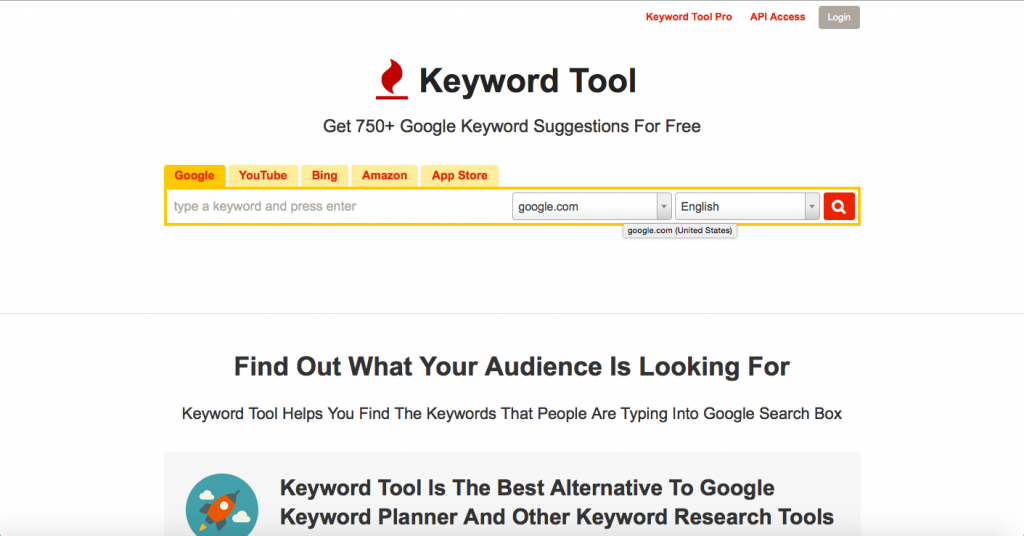
From here, you can type in one of the keyword phrases that you brainstormed. If you are on the free trial of Keyword tool, you will see something like this:
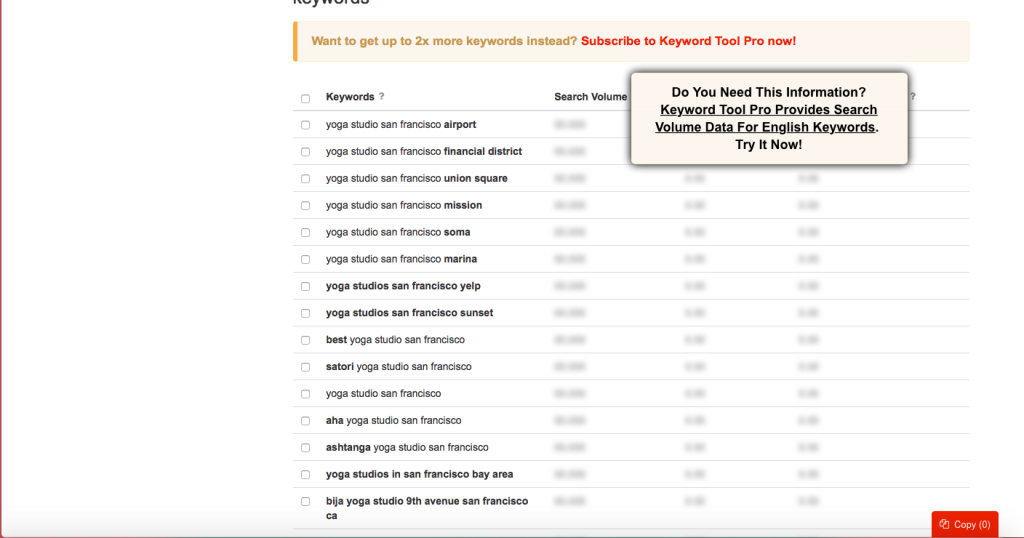
For an example, I typed in “yoga studio san francisco.” On the free version, a list of alternative keyword phrases will show up. This is a good starting point to brainstorm or add to the ideas you’ve already generated.
Notice that one of the most important deciding factors, search volume, is not available in the free version, but it, among other useful data reports, is available in either the basic or plus plans, which are $68 and $88 per month respectively.
Keyword Tool can be a great resource for starting a brainstorm if you feel stuck on one phrase, or it can add to your ideas based on popular search volume.
If you offer yoga in San Francisco, wouldn’t it be beneficial to see how many people per month are searching for “yoga studios in San Francisco?” But, maybe you didn’t think to look into “yoga near Union Square.”
Well, luckily Keyword Tool does it for you. And BOOM! Your studio is close to the specified area, and more people are searching that phrase than the other. Hypothetically, you’ve just successfully narrowed down your phrase options.
3. Narrow down your keywords.
From the data you gathered on your keywords, you now have a pretty good picture of how many search hits they are getting on a monthly basis. Now, it’s time to narrow, narrow, narrow! Remember, we are looking for the optimal choice. Not just any old Joe Shmo keyword!
This doesn’t mean that you shouldn’t include keywords that have a low search volume.What if you are offering a first-of-its-kind service or marketing a brand new product? Chances are people aren’t searching for it yet.
Even if your keyword tool returns an N/A or low search volume result on your words, it doesn’t mean that you shouldn’t use them. Like most marketing solutions, there isn’t a one-size-fits-all. You must make a decision that is right for your company, your site, your audience and your end goal.
In, fact there is a sweet spot when it comes to deciding on SEO keywords. Different ones have different difficulty ratings, and we suggest you take a look at those numbers before deciding on one.
4. Check the difficulty of those keywords.
Keyword difficulty is a measurement that determines how hard it will be for you to achieve a first-page search result ranking over your current competitors when using a specific SEO phrase.
Again, there are several online tools to choose from when it comes to measuring keyword difficulty.
One that we use often is Moz.com. Moz is a great resource that provides several marketing tools, including keyword search volume, opportunity and potential. The site outlines what each of these mean, but let’s take a look at difficulty and potential here.
Let’s say, for the sake of the above example, that I want to know more logistics on my search phrase “yoga near Union Square.” When I head over to Moz and click on the Keyword Explorer (in Moz Pro), I can type that phrase in and come up with the following:
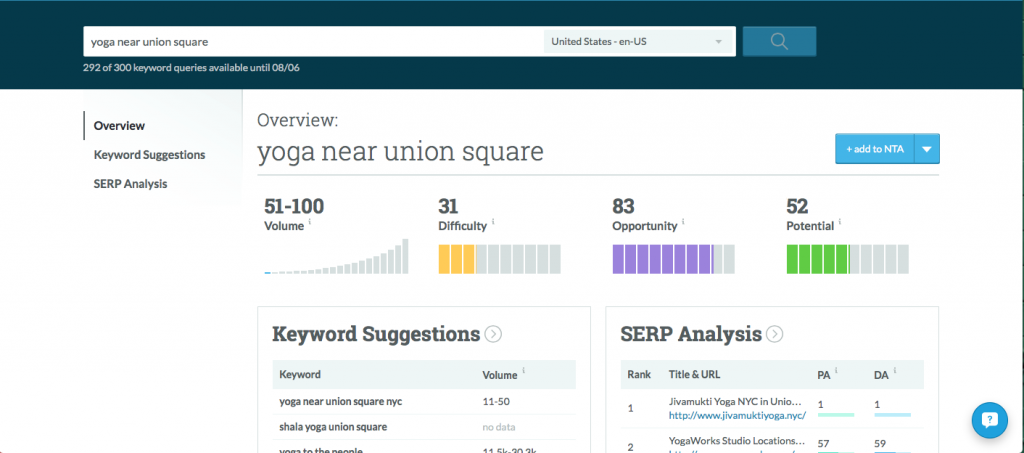
In the above picture, we can see a few things:
- The search volume (with at least 95% accuracy, according to Moz) is 51-100 search hits on Google per month for this specific keyword phrase.
- The difficulty for this phrase is 31 on a scale that ranges from 0 (easy) to 100 (difficult).
We typically shoot for a difficulty around 40 or lower with our keywords. Not to say that we never break from this mold, but a higher difficulty than that can mean you’re up against some pretty serious competition. You must know your place, and what tools you have at your disposal to understand your appropriate competition level.
Think about it this way: If you’re a small, mom-and-pop shop that sells used sports equipment, you may not be able to compete with the likes of Dick’s or Dunham’s, and you don’t need to to be successful. You need to find your target audience and cater to them with keywords that are more appropriate for your business.
We also see:
- An opportunity level of 83. Again on a scale from 0-100, opportunity measures “the relative click-through rate of organic web results [not paid for ads] of the first ten blue links for this keyword.” In this example, 83 means that there is a high opportunity that if your site is one of the first 10 search results, someone will click. The higher, the better of course.
- Finally, we arrive at potential. This is exactly what it sounds like – the potential of success for this specific keyword phrase. High potential = high volume + high opportunity + low difficulty. That’s the sweet spot!
This is a decent report for our example keyword phrase. In the hypothetical world, we’re sailing!
Back in the real world, once you have figured and compared the difficulty of your keywords, you can narrow your list further for the next step of the funnel by choosing those in the “sweet spot.”
You also want to keep in mind the benefit of long-tail versus short-tail keywords:
| Short-tail Keywords | Long-tail Keywords |
| General | Specific |
| High search volume | Low search volume |
| High competition | Low competition |
| These keywords are harder to rank for because the search volume is so high that you are putting yourself in a large ring of competition. The more businesses using the keywords, the less likely you are to get the search traffic. | These keywords are more likely to generate hits on your site. Because they are more specific, they increase the opportunity that your page’s keywords will more closely match someone’s search. They are also great because they include all of the short-tail keywords inside of them. Look at the examples below (As far as Google is concerned, these phrases include the correlating short-tail keywords in the opposite column, too.) |
| EX.
Shoes Jackets Books Universities Restaurants |
EX.
Men’s black suede dress shoes size 11 Fleece sports jackets size medium How to crochet for beginners books Universities within 5 miles of Midtown, Detroit Seafood restaurants with 5-star chefs |
Take all of this into consideration in step five.
5. Choose the best keyword or keyword phrase for your page.
All the data in the world can’t beat your knowledge of your target audience, which hopefully you have honed tremendously by this point. But there are some great tools that provide evidence for why you should make certain decisions.
Marketing shouldn’t be based on faith. To be utterly successful (and to be able to measure that success), you need stats. Numbers are your friend. But, this doesn’t mean that there is no room for creativity. In fact, the data is merely the legs upon which your creativity must stand on.
You want all of that beautiful, innovative content to reach your target audience. In order to be able to share it with them, you need to understand the where, what, how and why of their search habits. Understanding SEO helps with this.
Once you’ve narrowed your phrases down through the above steps, you need to pick ONE per page. This doesn’t mean that you won’t illuminate on other ideas throughout the page content, but there should only be a singular focus keyword or phrase per webpage for the best results.
You don’t want to focus on too many things or you won’t get picked up by Google for any of them.
Keep in mind that although your words have been selected because of statistical findings, your writing should definitely not sound robotic.
Awesomely, Google has gotten to the point where it can understand intent behind wording. This means that you don’t have to type the exact keywords in the exact order throughout your copy for Google to pick up on it. You can use synonyms and different arrangements to make the writing flow, be non-repetitive and sound human.
6. Get to writing.
You want to be sure to keep your users’ experience in mind when writing. If you focus so much on exact keyword verbiage that your writing sounds stiff or salesy, then you’ve done all of this work for nothing. Potential customers will leave your page. Most people don’t like to feel like they are speaking with a robot.
With Google’s ability to recognize content intent, you have some leeway in how you phrase things. Make sure that your copy sounds organic and flows throughout while keeping in mind the page hierarchy and the best places for your keyword phrases.
Some crucial spots to place the keywords are in the URL, the page title and the meta-description. Then, sprinkle them organically throughout the copy. Headlines, headers and subtitles are great homes for your keywords, as well. Just don’t forget to read through your drafts to make sure that your readers will enjoy the copy and feel like they’re having an organic experience.
Unless someone has a marketing eye, they shouldn’t be able to notice your SEO keywords immediately. Nothing should stick out to them besides the overall message and perhaps a CTA to get them to click further into the buyer’s journey.
Keyword Intent
Now that you know the process of picking great SEO keywords, you are almost ready to try this on your own. But before we turn you loose, we need to talk a bit about keyword intent. Essentially, this is the idea that not all keywords are created equally.
According to WordStream, “Keyword intent is one of the most crucial aspects of paid research.” This aspect has to do with understanding the intent behind those Google searches. What is driving the person on the other end to type those exact words into the search engine?
WordStream goes on to say that there are three general types of search inquiries: navigational, informational and transactional. Here’s their breakdown:
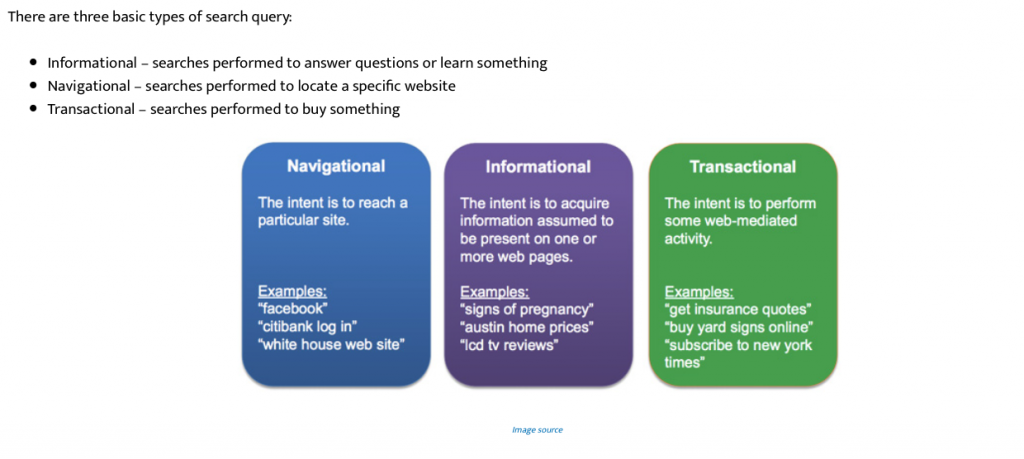
Image source: skilledup
The idea of commercial keyword intent deals primarily with transactional searches. If someone is starting off a search with the intent to buy a product or service, you want to be sure that your site is in one of the top results they see. Since they’re more likely to buy from the get-go, they have done a lot of the work for you.
Think of commercial intent as how likely someone is to buy. Transactional searches, therefore, rank higher than both informational and navigational. You can generate a lot of sales by optimizing your keywords to match transactional search verbiage.
Keywords with high commercial intent can be broken up further into two categories: “buy now” and “product.”
“Buy now” keyword searches include words like buy, discount, coupon or sale. These have high commercial intent as they signify that someone is looking to shop. “Product” keywords, while not as blatant, also show a possibility that the searcher wants to purchase. These searches may have words like comparison, top, reviews or cheapest and also include brand name, specific product and category searches.
Targeting only those searches that will match you to a person with high commercial intent – that is, they are likely to buy – will lead to higher conversion rates. Conversion is what happens when you move a lead (possible customer) into the buying process (becoming an actual customer).
It may seem like targeting specific searches is limiting your availability to a wider audience, but here again is where quality can actually lead to a healthier business than quantity. You want your website traffic to be full of converters. Good optimization is cost-effective because you are generating a higher spot on the SERP, which is leading to higher click-through and conversion rates, which equal sales.
There are online resources that can help you identify keywords with high commercial intent that are relevant to your business or industry, but you can successfully recognize them on your own if you take some time to step into the mind of your target audience members and build up your buyer personas.
What Excellent SEO Looks Like: An Example
For a real-life example of great SEO practices, I want to turn to HubSpot. HubSpot is an inbound marketing company that provides resources galore for those that want to keep up with the ever-changing landscape of how people shop, explore, etc online.
I have an ulterior motive when choosing HubSpot. Because it offers blogs and free classes on SEO, inbound marketing, email marketing and design, it is a great site to bookmark in case you want to keep on learning or even become certified!
What else does HubSpot offer? Well, just take a look at their homepage:
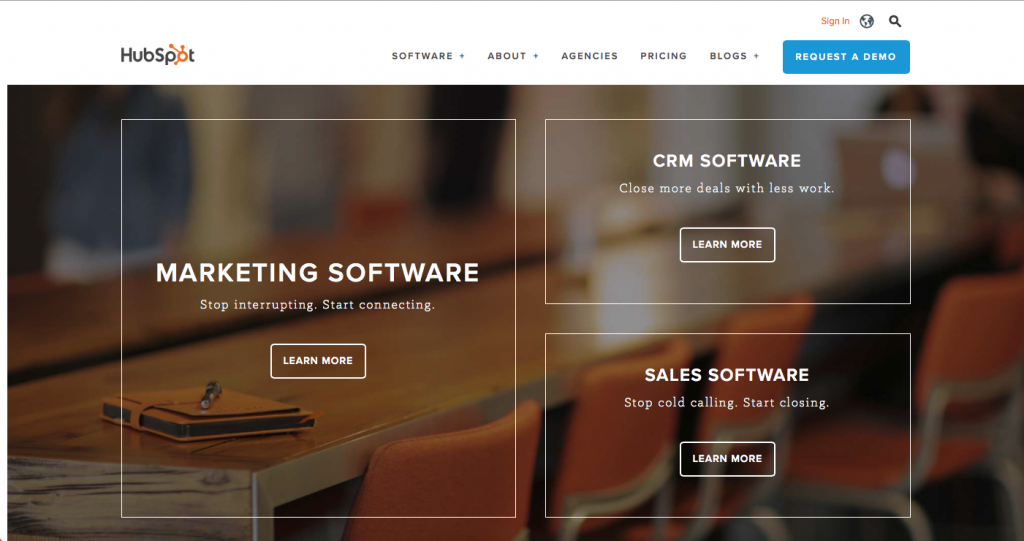
You can clearly see that they offer marketing software, CRM software and sales software. Scroll down, and you can see “The Inbound Community.”
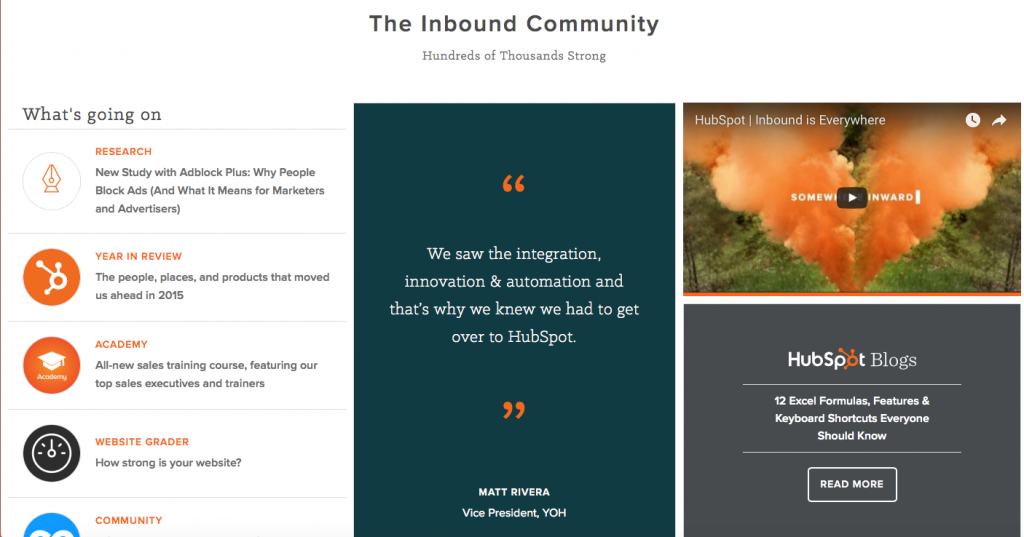
These concise headlines weren’t just thrown on this page. They were put there with SEO in mind. You’ll see what I mean if you Google “inbound marketing software.”
What’s the very first result that pops up? Mmmm….HubSpot. They also rank first on “inbound marketing strategy” and a ton of other searches, just so ya know. Give the site a look-over and see if you can pinpoint the keyword phrases.
This is a perfect example of how well-placed and well-thought-out keywords, while sounding fluid and organic to the reader, are a strategic business tool to obtain successful search engine optimization. HubSpot may be using systematic keywords, but the content on the page is informational, current and relevant. Also, most importantly, it doesn’t sound robotic.
Once the user clicks, it is your job to make sure your content has these attributes. When done correctly, this will prompt your viewers to buy, subscribe, enroll….or whatever it is that you want them to do.
In Conclusion
There are so many SEO resources online that it is unbelievable. We can’t cover it all here – there are whole books on this stuff!
But, we’d love to help you understand more about what you can do to increase your SEO and drive traffic to your site. If you’d like to discuss your project with us, please fill out our contact form and one of our team members will get back to you within one business day.
Do you have any questions or know of any terrific SEO resources or successful examples that you’d like to share? Comment below, and let’s get a conversation started!
